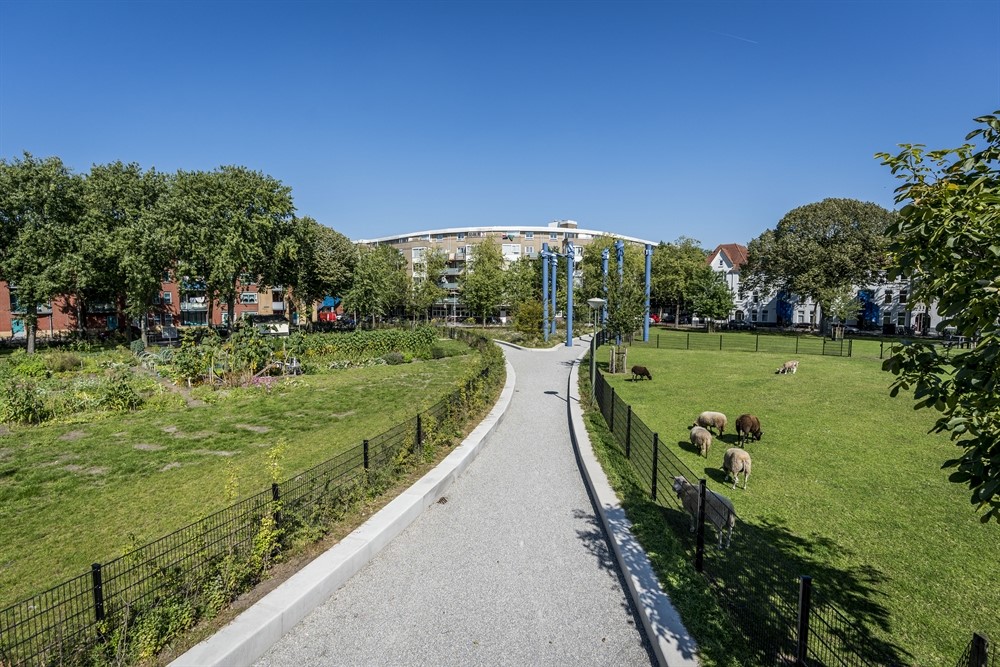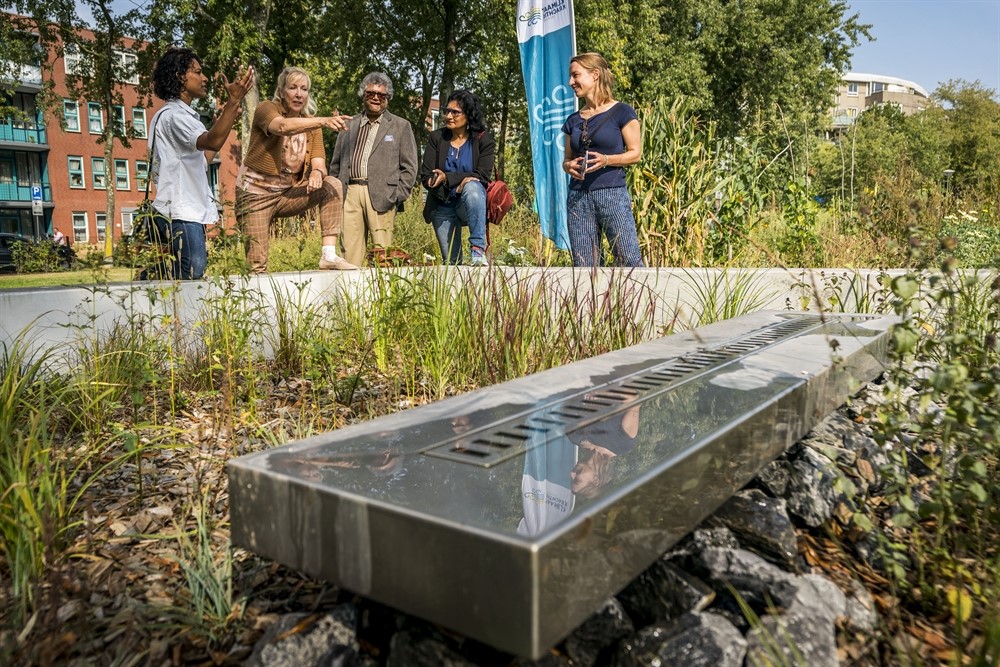Cromvlietplein square turned into community park with Urban Water Buffer
Cromvlietplein square in the Molenwijk neighbourhood of The Hague used to be characterised by asphalt, fences, and wide sidewalks. Over recent years, the municipality has joined forces with local residents, entrepreneurs, and the Coalitie Laak community association in order to turn Cromvlietplein square into a green and pleasant location for everyone to enjoy. This has resulted in Cromvliet Community Park, a climate-proof park featuring an Urban Water Buffer, in which Molenwijk residents can meet each other.

For what purpose was this new community park created?
The new community park was created to render the area greener and to enhance liveability and traffic safety. For that reason, the park needed to become a place for residents to meet, stroll about, and sit. In addition, it needed to provide room for schools and clubs to organise activities. The authorities sought to create a climate-proof park, featuring greenery to better protect visitors from summer heat stress. Furthermore, the new community park needed to be capable of rainwater collection and drainage.
How has Cromvliet Community Park been developed?
In 2017 and 2018, the municipality, Coalitie Laak community association, and Buro Sant en Co landscape architects outlined an initial design for Cromvliet Community Park and the surrounding roads, in collaboration with local residents. To this end, residents’ meetings and individual interviews were held. In 2018 and 2019 several design elements were elaborated in more detail by a group of more than thirty companies, including some local ones. In early 2019, the group was joined by the project group working on the Nature Smart Cities (opens in new window) (refers to another website) project in The Hague, which received a European grant under the EU Interreg 2 Seas Programme. This local project group introduced the Urban Water Buffer into the design.
How does the Urban Water Buffer work?
The Urban Water Buffer (UWB) collects and purifies rainwater, and subsequently stores the water deep below the surface. This increases the sponge effect of the environment and reduces the risk of waterlogging caused by severe downpours. In periods of drought, the water can be used for, e.g., watering plants in the petting zoo or in the vegetable garden. These plants will subsequently evaporate more water, thus providing additional cooling. The UWB not only collects rainwater falling in the immediate vicinity; rainwater falling on the rooftops of surrounding buildings is also directed to the Urban Water Buffer. Along with Staedion housing corporation, the municipality has disconnected 1,000 square metres of rooftops from the sewer system, to be connected to the UWB.
Interested in taking a look at the Urban Water Buffer? The municipality of The Hague has created a video on the construction of the UWB and a video on the opening ceremony, both of which can be viewed via YouTube. Or view the YouTube video created by Field Factors, one of the companies with expertise in UWB technology. The video created by Nature Smart Cities on the UWB can be viewed via Vimeo.
Developing knowledge with the Urban Water Buffer
In addition to consultancies – KWR, Field Factors, and Wareco – the Hoogheemraadschap van Delfland district water control board and Dunea drinking water company were also involved in the construction process. The UWB is currently in a test phase. During and after the test phase, water volumes and the water quality will be monitored. Thus, the municipality and its partners are developing knowledge on how to climate proof the city and on how to ensure a sufficient supply of fresh water in the long run.
How green has the Cromvliet Community Park turned out?
Seventy new trees have been planted at and around Cromvlietplein square, including beech, hawthorn, and oak but also apple, pear, and plum trees. All in all, some 2,000 square metres of greenery have been added. Roads have been narrowed and some of the sidewalks have been replaced with sections of plants, flowers, and hedges.
What activities does Cromvliet Community Park offer?
The square offers a host of activities for children, young people, and adults. It features a stage, a soccer cage, a large playground with a water tap, vegetable gardens, and a sustainable petting zoo. This petting zoo also accommodates a tearoom and constitutes a new meeting place. At various locations in the neighbourhood, picnic spots and green playgrounds have been created. The Krajicek Playground, a Cruyff court, and a running track offer plenty of opportunities for exercise.

Project has also fostered employment opportunities
The group of thirty companies, including local ones, has elaborated the design and carried out the work, involving local residents wherever possible. In addition, two sheltered workshops were established in the petting zoo and in the tearoom. This has boosted the park’s social return score: this approach has fostered employment opportunities in the neighbourhood.
Lessons to be learned
This project has generated the following lessons to be learned:
- In the project, ongoing implementation projects were linked to an EU implementation budget, which has the advantage of being able to speed up the ongoing implementation projects. However, it may entail the risk of insufficient coordination between processes and funding. Furthermore, it may hamper the integration of various spatial measures into the design.
- When collectively embarking on a new track, it is important to consider what is feasible and what is not.
- When launching a major local project, it is good to involve residents from the start. This increases their sense of ownership.
- Close collaboration – both within your own organisation and with external partners – is vital. Enter into the collaboration process with an open mind and flexible mindset, and dare to go along if others come up with ideas that do not immediately tally with your expectations.
Contact persons
John Nieuwmans
Gemeente Den Haag
John.nieuwmans@denhaag.nl
Wiebke Klemm
Gemeente Den Haag
Wiebke.Klemm@denhaag.nl
